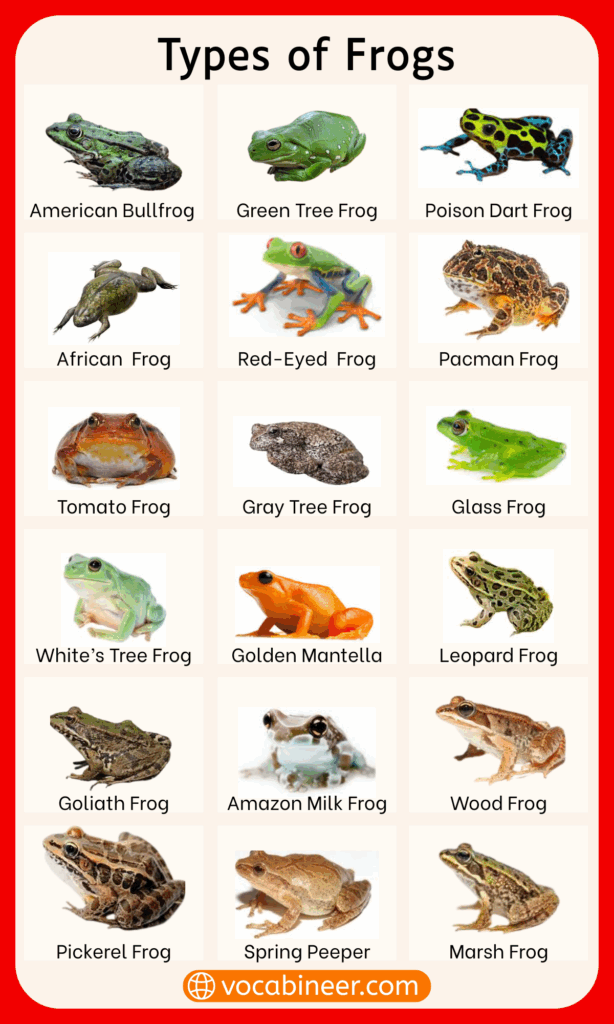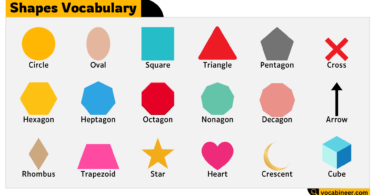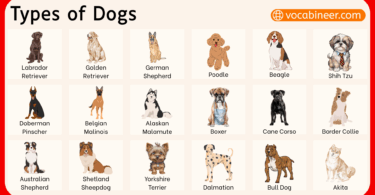Frogs are amphibians found worldwide, living in water, forests, grasslands, and even deserts. There are many types of frogs, from small tree frogs to giant bullfrogs, each with unique colors, sizes, and habitats. This guide explains the different frog species with names and pictures, helping you identify frog varieties easily for learning, gardening, or nature study.
In This Page
Common Frog Types and Species with Names
Tree Frog – Small frogs that live on trees, known for sticky toe pads and loud calls, found worldwide in warm, wet climates.
Pond Frog – Freshwater frogs living near ponds and lakes, often green or brown, feeding on insects, and commonly seen in gardens.
Grass Frog – Slim-bodied frogs that hide in grasslands and meadows, camouflaged for survival and active mostly during the rainy season.
Green Frog – Medium-sized amphibians with bright green skin, semi-aquatic habits, and a loud “plunk” call near lakes and streams.
Leopard Frog – Spotted frogs with leopard-like patterns, found across North America, excellent jumpers, and often used in school biology classes.
Common Frog – Native to Europe, these frogs are brown or green with smooth skin, living in both ponds and moist woodland areas.
Pickerel Frog – Recognized by square-shaped spots, these frogs prefer cool, clear streams and release mild toxins to deter predators.

Colorful Frog Names and Tropical Frog Species
Poison Dart Frog – Brightly colored frogs from Central and South America, famous for their toxic skin used by tribes for hunting.
Red-Eyed Tree Frog – Iconic frogs with big red eyes and green bodies, known for jumping between tropical leaves in Central America.
Golden Mantella Frog – Small, bright orange frogs from Madagascar, endangered but popular in captivity for their striking appearance.
Strawberry Poison Frog – Tiny but vibrant red frogs with blue legs, found in Central America, known for parental care of tadpoles.
Blue Poison Dart Frog – Brilliant blue skin with black spots, highly toxic in the wild, but bred safely in many pet collections.
Tiger-Legged Monkey Frog – A rare Amazon species with striped yellow and black legs, often climbing trees and moving slowly like monkeys.
Aquatic Frogs – Water Frog Names and Amphibians
African Clawed Frog – Fully aquatic frogs with clawed toes, often kept in laboratories and aquariums, thriving in freshwater environments.
Water-Holding Frog – Australian desert frogs that store water in their bodies, surviving drought by burrowing underground until rains arrive.
Surinam Toad – Flat-bodied frogs where females carry eggs inside their backs, creating one of the strangest amphibian life cycles.
Ornate Horned Frog (Pacman Frog) – Large, round frogs with wide mouths, native to South America, known for eating anything that fits inside.
Floating Frog – Southeast Asian frogs that float on water surfaces, using skin folds to breathe while resting and avoiding predators.
Ground Frogs and Toad Species
Bullfrog – Large frogs with loud calls, often found near lakes and rivers, feeding on insects, fish, and even small birds.
Cane Toad – A giant invasive toad in Australia, originally from South America, toxic to predators and harmful to local ecosystems.
Wood Frog – Known for surviving freezing winters, these North American frogs can thaw back to life after being frozen solid.
Spadefoot Toad – Desert-dwelling toads with shovel-like feet for digging, emerging only during heavy rains to breed quickly.
Southern Leopard Frog – A spotted frog from the southeastern U.S., found near marshes and wetlands, recognized by quick jumps and calls.
Small and Unique Frog Species with Names
Glass Frog – Transparent-bellied frogs where organs are visible, found in Central and South America, blending perfectly with wet leaves.
Rain Frog – Small, round frogs that burrow underground, inflating their bodies to scare predators and making squeaky rain-like calls.
Spring Peeper – Tiny frogs from North America, famous for their loud “peep” calls heard in early spring.
Chorus Frog – Small frogs that call together in groups, producing loud evening sounds during breeding season.
Narrow-Mouthed Frog – Insect-eating frogs with pointed snouts, living underground and feeding mainly on ants and termites.
Large Frog Types and Giant Frog Names
Goliath Frog – The world’s largest frog, reaching up to 32 cm, found in Africa, strong enough to move rocks when nesting.
American Bullfrog – Giant frogs from North America, with booming calls and aggressive feeding habits, often eating snakes, birds, and fish.
African Bullfrog – Heavy, aggressive frogs from Africa, capable of eating rodents, birds, and other frogs.
Cuban Tree Frog – Large tree frogs from the Caribbean, invasive in Florida, able to adapt to urban environments.
Pet Frog Types and Popular Frog Names
Pacman Frog – Popular pet frog with a huge mouth and round body, easy to care for and comes in bright colors.
White’s Tree Frog – Friendly frogs from Australia, commonly kept as pets, known for their docile nature.
Tomato Frog – Bright red-orange frogs from Madagascar, secreting a sticky substance when threatened.
Fire-Bellied Toad – Small amphibians with bright red bellies, often kept in aquariums as pets.
Budgett’s Frog – Also called the “Hippo Frog,” a strange-looking species from South America, famous for its flat body and wide mouth.
Rare and Exotic Frog Species with Names
Darwin’s Frog – Unique frog from Chile, with males carrying developing tadpoles in their mouths until they are fully grown.
Amazon Milk Frog – Beautiful gray and blue frogs from the Amazon rainforest, releasing a milky fluid for protection.
Malayan Horned Frog – Camouflaged frog with horn-like skin flaps above eyes, blending into forest floors.
Wallace’s Flying Frog – Gliding frog from Asia, using webbed feet to leap between trees.
Vietnamese Mossy Frog – A rare frog covered in moss-like skin, blending with rocks and trees.
Frog vs. Toad: Key Differences Explained in a Comparison
| Feature | Frogs 🐸 | Toads 🐸 |
|---|---|---|
| Skin | Smooth, moist, and slimy | Dry, rough, and bumpy |
| Body Shape | Slim and narrow | Short, stout, and round |
| Legs | Long, strong legs for jumping | Shorter legs for walking or small hops |
| Habitat | Prefer water and moist areas | Can live in drier places away from water |
| Eggs | Laid in clusters or masses | Laid in long chains |
| Movement | Great jumpers and swimmers | Slow movers, mostly crawling |
| Lifespan | Usually shorter (average 4–10 years) | Can live longer (up to 10–15 years) |
FAQs about Different Types of Frogs
There are over 7,000 frog species worldwide, found in rainforests, deserts, wetlands, and even cold regions.
The Common Frog (Rana temporaria) is one of the most widespread, especially across Europe in ponds, lakes, and woodlands.
The Goliath Frog from Africa is the largest, growing up to 32 cm long and weighing more than 3 kg.
Poison Dart Frogs are the most colorful, with bright blue, red, yellow, and green patterns that warn predators of their toxicity.
Yes, frogs are amphibians, meaning they live both in water and on land, though some species are more aquatic and others more terrestrial.
Read More




